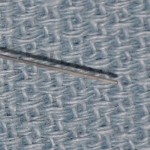Injectable fillers are right behind Botox injections as a leading non-surgical facial rejuvenation procedure. While both require needles to be inserted, injectable fillers are deemed by patients and providers alike to be the more painful to receive. This is for two main reasons, a much larger volume of filler is needed for each treatment area and sensitive areas like the lips are frequently injected.
Numerous strategies to reduce injectable filler discomfort are used from ice skin cooling, topical numbing creams to dental block injections. While these are all helpful, none completely reduce the pain or potential bruising from the fine sharp needle used for the injection. (except for dental blocks which have the trade-off of having the lips numb for hours) In the end, the sharp bevel of the injection needle induces discomfort by cutting into tissue and risks some bruising by similarly cutting across small blood vessels.



Because the tip of the cannula is blunt, it can not pierce the skin. I simply make an entrance point with a 25 gauge needle so the microcannula can easily pass below the skin. I will inject a tiny drop of local anesthetic at the desired entrance point with a 30 gauge needle first. Once under the skin the flexibility of the microcannula allows it to bend and be maneuvered unlike a rigid straight needle.
While this is a real improvement in injectable filler therapy, one of the company’s product claims is suspect. Using what is called a Skin Sculpting Technique (SST), the microcannula’s back-and-forth movement (mechanical stimulation) is purported to stimulate fibroblast and produce new collagen formation.
While the collagen creation claim is going to be difficult to prove, no injectable filler patient is going to doubt the pain-free use of the new Dermasculpt micro-cannula.
Dr. Barry Eppley
Indianapolis, Indiana


